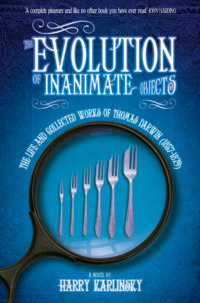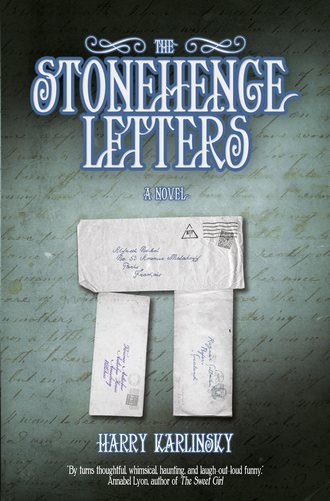
Полная версия
The Stonehenge Letters

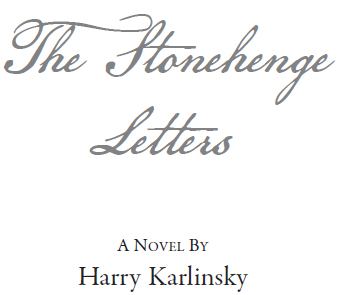

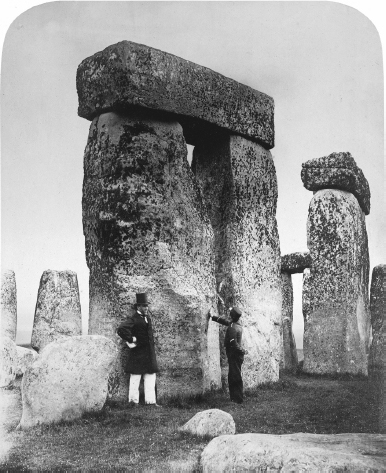
Trilithons B and C from the south-west, Stonehenge, c. 1867.
Dedication
For Minnie and Will
They look upon me as pretty much of a monomaniac, while I have the distinct feeling that I have touched upon one of the great secrets of nature.
Sigmund Freud, Letter to Wilhelm Fliess, 21 May 1894
CONTENTS
Cover
Title Page
Dedication
Epigraph
Introduction: The Knäppskalle File
Part One: Alfred Nobel’s Last Will and Testament
Chapter 1. Alfred Nobel
Chapter 2. Lilljeqvist and Sohlman
Chapter 3. Nobel’s Last Will and Testament
Part Two: An Unexpected Prize
Chapter 4. ‘Frau Sofie’ and Countess Bertha Kinsky
Chapter 5. Stonehenge for Sale
Chapter 6. Florence Antrobus
Chapter 7. The Secret Codicil
Chapter 8. The Royal Swedish Academy of History, Letters, and Antiquities
Chapter 9. A Sentimental and Practical Guide to Stonehenge
Part Three: The Mystery of Stonehenge
Chapter 10. Great Stones Undermined by Worms
Chapter 11. When Stonehenge was New
Chapter 12. Seaborne Stones
Chapter 13. The Curve of Knowns
Part Four: Deliberations
Chapter 14. 10 December 1911
Chapter 15. The Grand Hôtel
Chapter 16. Trivial and Flawed
Chapter 17. Albert Einstein
Chapter 18. Dear Lady Antrobus
Part Five: Epilogue
Postscripts
Appendix I: A Psychological Autopsy – A Diagnostic Listing of Alfred Nobel’s Dominant Personality Traits, Defence Mechanisms, and Primary Mental Disorders
Appendix II: Acute Radiation Poisoning – Psychosomatic Variant
Footnotes
Bibliography
Author’s Notes and Acknowledgments
Sources for Quotations
Also by Harry Karlinsky
Credits for Illustrations
Copyright
About the Publisher
INTRODUCTION
THE KNÄPPSKALLE FILE
As a (now retired) psychiatrist and amateur historian, I had long been vexed that the clearly deserving Sigmund Freud (1856–1939) had never received the Nobel Prize. In my younger years I had attempted to uncover the reason for this remarkable omission by contacting the Nobel Foundation in Stockholm, the overarching body responsible for the administration of the Nobel Prizes. I was politely but firmly informed that, according to the foundation’s statutory rules, ‘Proposals received for the award of a prize, and investigations and opinions concerning the award of a prize, may not be divulged’. This stipulation meant that neither the names of those nominated for a Nobel Prize nor the subsequent prize deliberations were made known to the public. As it was more patiently explained to me, the Nobel Foundation could not and would not confirm whether Freud had ever been under consideration for the prize, let alone release the adjudicative details of his evaluation had he ever been nominated.
I was disappointed but not deterred. Though the official channels were closed, the secrecy of the Nobel Prize selection process was not impenetrable. With time and the energy of youth, I was able to glean references to Freud and the Nobel Prize from a large number of unofficial sources. These included the personal diaries of his nominators as well as the private and public correspondence of those who lobbied on Freud’s behalf. By my count, Freud had been proposed for the Nobel Prize in Medicine thirty-three separate times between the years 1915 and 1938, once achieving fourteen nominations in the year 1937. It was outrageous that Freud had been overlooked for a Nobel Prize on so many occasions. Yet, despite assertively contacting the Nobel Foundation again and again, I could elicit no explanation for this shameful state of affairs.
In 1974, however, the Swedish government’s introduction of new freedom of information legislation had an unintended consequence, one that would dramatically affect the outcome, and direction, of my enquiries. Recipients of the Nobel Prizes in Literature, Physics, Chemistry and the Economic Sciences were then, as now, decided by the Swedish Academy and the Royal Swedish Academy of Sciences, both private institutions.fn1 In contrast, it was a publicly funded medical university – Sweden’s Karolinska Institute (Institutet, in Swedish) – that determined who received the Nobel Prize in Medicine. As the new legislation afforded access to documents retained in public institutions, the secrecy of the Karolinska Institute’s prize deliberations was now in jeopardy. The Karolinska Institute manoeuvred quickly. A new private body was created and tasked by the faculty of the Karolinska Institute to bestow its prize, thereby preserving the secrecy of its selection.
These crude shenanigans to circumvent freedom of information did not go unnoticed. The Swedish government immediately demanded that the secrecy surrounding the awarding of all the Nobel Prizes be lifted. After contentious negotiations, a key conciliatory revision within the statutes of the Nobel Foundation emerged as follows:
A prize-awarding body may, however, after due consideration in each individual case, permit access to material which formed the basis for the evaluation and decision concerning a prize, for purposes of research in intellectual history. Such permission may not, however, be granted until at least fifty years have elapsed after the date on which the decision in question was made.
I was delighted. With access to the Nobel Archives now available, I was determined to learn the real truth, sordid or otherwise, behind Freud’s lengthy series of disappointments.
After years of inadvertent delay for both professional and personal reasons,fn2 I at last arrived in Stockholm in the spring of 2013 to conduct my research. The twenty-nine-letter Swedish alphabet was an immediate and unexpected challenge; fortunately, undergraduate students from Stockholm University were available to translate documents at a reasonable ten Swedish kronor per page. The greater obstacle, however, lay with the quality of available records, which fell into four groupings: letters of nomination, reports on candidates, minutes of the working committees and minutes of the larger voting assemblies. It was the nature of the material in the latter two categories that was most limiting. Instead of unearthing detailed and candid discussions of the relative merits of Freud’s work as I had envisioned, only tallies of votes and final decisions were recorded.
I abandoned the effort altogether when an obliging student, aware of my interest, drew my attention to an obscure article by a Swedish psychiatrist, Dr Carl-Magnus Stolt, titled ‘Why Did Freud Never Receive the Nobel Prize?’ Stolt had already reviewed the relevant archival material, leaving no doubt as to either the priority or the thoroughness of his findings. In brief, Freud’s candidacy was based on those accomplishments one would expect to be cited: his courageous new insights concerning the unconscious, the significance of dreams, and the stages of infantile sexuality; his development of such novel concepts as the id, the ego, and the superego; and perhaps, most importantly, his introduction of psychoanalysis. As a number of his nominators stressed, Freud’s so-called ‘talking cure’ was the first effective treatment for a range of psychological disorders, including hysteria and the sexual perversions.
Yet Freud’s repeated rejections were not for the reasons I had suspected. Stolt found no indication that either anti-Semitism or the personal animosity of members on the Nobel Committee had undermined Freud’s chances. There was also no evidence that political considerations had constituted a factor, such as the fear that Freud’s selection in the 1930s might incite Nazi Germany. Instead, Freud’s work – at least as judged in the official documents – was viewed as too subjective for traditional scientific evaluation. In a cruel twist, one of the most damaging observations used against Freud was that he was also aggressively promoted for the Nobel Prize in Literature, once earning an official nomination from the French author and Nobel Laureate Romain Rolland. The flattering appraisal that Freud’s case studies lent themselves well to the conventions of fiction undermined any perception of Freud as an objective physician–scientist.
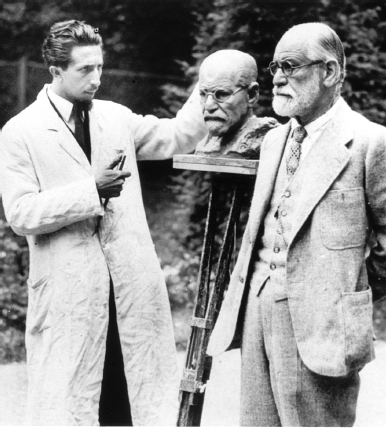
Figure 1. Sigmund Freud.
Disheartened, I considered other lines of investigation. As Freud had never encountered or written about Alfred Nobel (the man whose fortune was used after his death to finance the Nobel Prizes), I first distracted myself by reconstructing Nobel’s emotional life by way of Freud’s psychological principles. Once this small exercise was completed (see Appendix I), I then sought to clarify whether any psychiatrist had ever been awarded the Nobel Prize in Medicine. There were two: the first was Julius Wagner-Jauregg who, in 1927, earned the prize for his discovery that malaria inoculation could be effective in the treatment of neurosyphilis, at that time an incurable disease.fn3 The second psychiatrist-laureate was Eric R. Kandel, a co-winner in 2000 for delineating the physiological basis of neuronal memory. Neither of these individuals nor their respective areas of research were of particular interest. Nor were the brutal surgeries of António Egas Moniz, a Portuguese neurologist often incorrectly assumed to be a psychiatrist. Moniz won a 1949 Nobel Prize in Medicine for developing the now-discredited leucotomy (or ‘lobotomy’), a barbaric surgical procedure that he recklessly inflicted upon psychotic patients. Ironically, Moniz would have made a far more legitimate Nobel Laureate for his pioneering radiological investigations of the carotid arteries and other vasculature, work for which he also received Nobel nominations.fn4
For a period of time, I attempted to compile a list of Nobel Laureates who had been analysed by Freud. Although I failed to uncover any such individuals within Freud’s relatively small circle of patients, I had more success identifying those Nobelists treated within the wider psychoanalytic community. Saul Bellow, winner of the Nobel Prize in Literature in 1976, was especially indebted to Freud’s disciples. Analysed by at least four well-known therapists, Bellow once shared his apartment with an Orgone Accumulator, a large zinc-lined rectangular crate roughly the size of a small outhouse. The contraption, invented by the controversial psychoanalyst Wilhelm Reich, ostensibly ‘accumulated’ orgone, an allegedly ubiquitous life force supposed essential for sexual vitality. Bellow was reported to have retreated into his Orgone Accumulator for hours, most often to read, but periodically to gag himself with a handkerchief and then unabashedly scream out for sexual release.
I was also aware, of course, of the profoundly disturbed nightmares of Wolfgang Pauli, winner of the Nobel Prize in Physics in 1945. These so interested the Swiss psychoanalyst Carl Jung that he published interpretations of four hundred of Pauli’s dreams and visions in what became the twelfth volume of Jung’s Collected Works.fn5 Jung and an apparently healthier Pauli subsequently collaborated on the subject of ‘synchronicity’: unrelated events that occurred together as ‘meaningful coincidences’. The resulting work was a completely mad fusion of quantum mechanics and parapsychology.
I was soon able to accumulate the names of more than forty other laureates who, like Bellow and Pauli, had benefited substantially from psychoanalysis. Again, however, I discontinued my enquiries, this time on re-examining my motives and recognising my real agenda: a childish means of highlighting Freud’s disgraceful oversight by the various Nobel Prize selection committees. In truth, it was more personal than that. Fifty-five years ago, I was inspired by Freud’s writings to choose psychiatry as my profession. For forty-five years, I practised psychotherapy utilising Freud’s principles. As I approached retirement, I was uncomfortably aware that Freud was no longer venerated in the psychiatric community and that the prestige of psychoanalysis as a discipline was in rapid decline. Indeed, there were ‘biological’ psychiatrists who dismissed Freud’s theories as the unverifiable beliefs of a man bordering on madness. More than once I had to defend the nature of my work to the (much younger) Chair of my Department. In now numerating and restating Freud’s accomplishments, and re-examining his Nobel defeats, it was obvious I was also attempting to legitimise my own career in the process.
I was in the midst of these private musings, when – browsing aimlessly in the Nobel Archives – I stumbled upon the ‘Crackpot’ file, the source of the remarkable story that follows. Nominations for each Nobel Prize are intended to be elicited only by invitation. Each year, the various Nobel Prize Committees invite, in confidence, thousands of qualified individuals, including all previous Nobel Laureates, to nominate deserving candidates other than themselves. Those names proposed by invited nominators – the ‘official’ nominees – are then considered for the coming year’s Nobel Prizes. Despite well-publicised admonitions that only official nominations are adjudicated, the Nobel Prize Committees still receive a substantial number of unsolicited applications, many from individuals who nominate themselves on the basis of questionable achievements. These unsought applications are immediately consigned to the B file, or the Knäppskalle (‘Crackpot’) file as the committee members more affectionately know it, and are rife with such claims as well-intentioned but ill-conceived cures for cancer and flawed designs for perpetual motion machines. The file made for sad but compelling reading and I began to spend more time perusing its contents.
It soon became evident, to a psychiatrist at least, that a significant proportion of those who nominated themselves were in the throes of serious psychiatric illness. Untreated mania, with its pathognomonic features of inflated self-esteem and irrepressible self-confidence, was pervasive. Euphoric applicants, without any prior training or demonstrated expertise, were pronouncing definitively on such matters as pandemics and elementary particle physics or declaring lengthy and incoherent memoirs as great works of literature. Of more concern were those applications fuelled by the bizarre delusions of individuals with psychotic disorders. The frequency of such submissions suggested that there might be merit in conducting a formal review of all unsolicited applications in an attempt to establish the underlying prevalence of psychopathology. Perhaps the resulting data might also identify a unique cluster of symptoms precipitated by the siren song of a Nobel Prize.
As the Knäppskalle file was organised by year of application, I began in 1901, the first year in which the Nobel Prizes were awarded. The number of entries on file increased substantially each year and it was difficult not to be impressed by the range and power of the human imagination, diseased or otherwise. One submission in particular caught my attention. Handwritten in Russian, it contained three unusual figures, two of which related to earthworms. The third, torn from a text written in English, was a sketch depicting ‘one of the fallen Druidical stones at Stonehenge’. Intrigued, I requested the assistance of a translator. In brief, the submission’s central thesis was that a causal relationship existed between the digestive habits of earthworms and why the enormous stone pillars at Stonehenge were gradually sinking into the ground. Despite its unusual supposition, it was a serious account and appeared to have been written as a focused response to an enquiry from a Mr Sohlman.
By this stage in my research, I was able to recognise Sohlman’s name as that of the principal executor of Alfred Nobel’s will and, for many years, the executive director of the Nobel Foundation. To my surprise, I also recognised the applicant’s name: Ivan Pavlov, winner of the 1904 Nobel Prize in Medicine. Although I had not been exposed to Pavlov’s work on classical conditioning since the early years of my psychiatric training, the submission’s arguments and style of writing seemed consistent with Pavlov’s well-known reputation for meticulous observation and measurement. Perplexed, I continued my review of the Knäppskalle file, utilising translators as required, until it was complete.
In the end, five other letters related to Stonehenge were addressed to Mr Ragnar Sohlman. Remarkably, early Nobel Laureates had written all but one. Even more remarkably, all alluded to solving the ‘mystery’ of Stonehenge.
And so began my journey of discovery, from Ivan Pavlov to Theodore Roosevelt to Rudyard Kipling to Marie Curie to Albert Einstein to a gentleman by the name of Norman Lockyer.
Or, as Freud once said more eloquently, ‘From error to error, one discovers the entire truth’.
CHAPTER 1
ALFRED NOBEL
For those readers unfamiliar with the early history of the Nobel Prizes, the man in whose honour they were named – Alfred Bernhard Nobel – was born in Stockholm, Sweden, in 1833. The third eldest of four sons (two younger siblings died in infancy), Alfred’s childhood years in Sweden were spent in relative poverty. His father, Immanuel Nobel, a self-taught pioneer in the arms industry, had been forced into bankruptcy the year of Alfred’s birth. Immanuel subsequently left his wife Andriette and their children in Sweden to pursue opportunities, first in Finland and later in Russia, that would re-establish the family’s wealth. It was not until 1842 that the Nobel family was reunited in St Petersburg. By then, Immanuel had convinced Tsar Nicholas I that submerged wooden barrels filled with gunpowder were an effective means to protect Russia’s coastal cities from enemy naval attack. This was surprising, as virtually all of Immanuel’s brightly painted underwater mines failed to detonate, even those brought ashore and struck severely with hammers.
Due to the ongoing military tensions that eventually led to Russia’s involvement in the Crimean War (1853–1856), Immanuel’s munitions factory prospered and Alfred’s adolescent years in St Petersburg were privileged. With the assistance of private tutors, he became fluent in five languages and excelled in both the sciences and the arts. At age seventeen, Alfred was sent abroad for two years in order to train as a chemical engineer. In Paris, his principal destination, he was introduced to Ascanio Sobrero, the first chemist to successfully produce nitroglycerine. On Alfred’s return to St Petersburg in 1852, he and his father began to experiment with the highly explosive liquid, initially considered too volatile to be of commercial value.
Despite initial setbacks, Alfred Nobel quickly established himself as a talented chemist and aggressive entrepreneur. His most important discoveries – the detonator, dynamite, and blasting gelatin – would form the lucrative underpinnings of an industrial empire. By the time of his death in 1896, Nobel held 355 patents and owned explosives manufacturing plants and laboratories in more than twenty countries. According to his executors, his net assets amounted to over 31 million Swedish kronor, the current equivalent of 265 million American dollars.
As his legacy, Nobel directed in his will that his immense fortune be used to establish a series of prizes. These were to be annual awards for exceptional contributions in the fields of physics, chemistry, physiology or medicine, literature, and peace. The will then ended with a curious closing directive:
Finally, it is my express wish that following my death my veins shall be opened, and when this has been done and competent Doctors have confirmed clear signs of death, my remains shall be cremated in a so-called crematorium.
It was Freud who stated that there was no better document than the will to reveal the character of its writer. Nobel was terrified of being buried alive, a phobia termed taphophobia (from the Greek taphos, for ‘grave’). The triggering stimulus, at least as cited in Nobel’s conventional biographies, was Verdi’s opera Aida. Nobel had attended its European premiere at La Scala, Milan, on 8 February 1872 and was deeply affected by the closing scene. Aida, a slave in Egypt (but, in truth, an Ethiopian princess), chooses to join her condemned lover Radamès as he is about to be sealed within a tomb. Horrified by the imagery of their impending immurement, Nobel immediately developed a deep-rooted fear that he, too, was destined to die while sentient and trapped. To address his anxiety, Nobel first carried a crowbar on his person. He next relied on a ‘life-signalling’ coffin of his own design.fn6 In the end, Nobel trusted on the certainty of cremation. It was only on realising he was now at risk for being burned alive, as opposed to buried alive, that a cautious Nobel also stipulated that his ‘veins shall be opened’ prior to his cremation (i.e., exsanguination by way of phlebotomy).
Years later, Nobel was to die suddenly in San Remo, Italy. As his will, the provisions of which were unknown to others, was on deposit in a private Swedish bank, it took three days before his executors learned of his morbid last wishes. By then, Nobel’s corpse had been embalmed, a standard funerary practice in Italy during the 1890s and a process that, by good fortune, begins with bleeding the veins of the deceased.
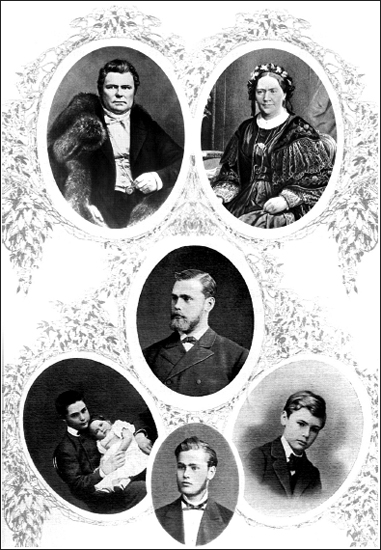
Figure 2. The Nobel Family. Immanuel Nobel (top left), Andriette Nobel (top right), and the Nobel brothers: Robert, Alfred, Ludvig, and baby Emil (bottom, clockwise from top).
Sadly, even Nobel had recognised he was troubled throughout his life by more than an operatic death scene. Though capable of congenial social interactions and outright levity in the right company, Nobel had lived a lonely existence without a lifelong partner or children. It was a lament he would frequently share, even in letters to strangers, as evidenced by the following admission:
At the age of 54, when one is completely alone in the world, and shown consideration by nobody except a paid servant, one’s thoughts become gloomy indeed.


